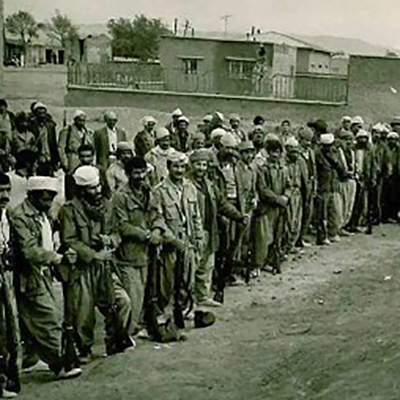Groups, Institutions, Organiza
Gomjan
Written by: Mohsen Shirmuhammad,
Translated by: Hadi Qorbanyar
20 دورہ
The Joint Unconventional Warfare Taskforce (Gomjan) was composed of Iranian tribal forces who were trained by the Iranian Army during the Iran–Iraq War to defend the country.
The formation of Gomjan dates back to the early days of the war. In the first week of the conflict, the Joint Chiefs of Staff of the Iranian Army decided to arm, equip, and organize the tribes of western Iran. At that time, the Joint Chiefs of Staff also acted as the Coordinating Headquarters of the Commander-in-Chief, overseeing and directing overall military operations. Therefore, the mobilization of the western tribes was technically outside its formal jurisdiction.[1]
Karim Sanjabi, then Minister of Foreign Affairs in the Provisional Government of Iran, who was a member of the Sanjabi tribe himself, was invited to help organize the mobilization of the tribes.[2] On September 29, 1980, the Western Tribal Mobilization Command, led by Major Mahmoud Rostami, departed Tehran for the western fronts under the name Expeditionary Column of the Joint Chiefs of Staff. The group consisted of 7 officers, 20 noncommissioned officers, 3 civilian staff, and 27 soldiers—a total of 57 personnel. They were stationed in Mahidasht, Kermanshah, where they began organizing, arming, and training local tribes as part of the “Tribal Mobilization”.[3]
By 9 November 1980, they had distributed 6,280 Brno rifles and 270 M1 rifles among the Sanjabi, Guran, Kalhor, Osmanvand, Valadbeigi, Jalalvand, Zardalan, and Sar-Firuzabad tribes. Around 20,000 volunteers also registered to join Gomjan.[4]
After the arming phase, the tribal units were structured and named after their respective tribes, such as the Sanjabi Regiment, Kalhor Regiment, and Qul-Khan Regiment. Each regiment had two battalions of 400 men, making a total of 800.[5]
The Joint Chiefs of Staff Headquarters took responsibility for providing the necessary equipment, vehicles, and communication systems for the Gomjan tribal forces.[6]
The arming of western tribes, especially during the early stages of the war, had a strong psychological impact and symbolic importance. National media outlets widely reported the deployment of tribal forces to Sarpol-e Zahab and Gilan-e Gharb using headlines such as “30,000 Tribesmen from Western Iran Ready and Deployed to the Frontlines” and “200,000 Tribal Forces from Western Iran Prepared to March to Battle”.[7]
After organization, the Gomjan tribal forces were assigned to secure a wide area from the Kermanshah–Eslamabad-e Gharb, Qalaje, Sarcheleh, and the Nasler-Balaler heights, to Tangab, Kermanshah, Qazanchi, Kuzaran, Bayangan, Mirabad, Bazmirabad, and Dasht-e Zahab.[8]
The first operation carried out by Gomjan forces took place on October 6, 1980, when they confronted an enemy offensive in the Gilan-e Gharb.[9]
At the onset of the imposed war, Gomjan established some bases in Deh-Sorkh, Maleh-Kaboud, Palan, and Bazmirabad along the Sarpol-e Zahab–Eslamabad axis in Kermanshah Province. By pushing enemy elements back across the border, they succeeded in securing the Sarpol-e Zahab–Eslamabad corridor.[10]
Gomjan took part in several major operations during the war, including the offensive at Tang-e Hajian (January 4, 1981);[11] the three-stage liberation of the Bazideraz Heights (December 6, 1980; April 22, 1981; and September 2, 1981);[12] the capture of the Gari Heights in Dasht-e Zahab (July 6, 1981);[13] and Matla al-Fajr in Shiyakuh (December 11, 1981).[14]
They also participated in Operation Moslem ibn Aqil in Soumar on October 1, 1982,[15] alongside units from the Army and the Islamic Revolutionary Guard Corps (IRGC). The operation led to the liberation of 150 square kilometers of occupied territory, including the Kohneh-Rig and Giskeh mountains in the Soumar region.[16] From June 28, 1983, to December 27, 1986, Gomjan forces engaged in defensive operations along the Naftshahr–Soumar axis.[17] During their deployment in Soumar, the area was hit by a large-scale chemical bombardment on December 31, 1986, resulting in injuries to 400 personnel. The severity of the attack caused extensive casualties, and even the pack mules used for transporting supplies across the rugged terrain were killed.[18] The commander of the Gomjan tribal forces also temporarily lost his eyesight due to chemical exposure.
According to the resolution of the Supreme Defense Council, the supervision of the western tribal forces had been initially assigned to the Army Ground Forces on April 1, 1985.[19] As the war continued, the recruitment, organization, training, and deployment of volunteer forces were, by law, transferred to the IRGC. Accordingly,[20] on April 4, 1987, in compliance with an order from the Khatam al-Anbiya (pbuh) Headquarters, issued based on the directive of the Supreme Defense Council, this responsibility was formally handed over to the IRGC.[21] The unit was then stationed along a 25-kilometer front in the Naftshahr–Soumar region to defend the area.[22] This marked the end of the Gomjan tribal forces’ activities.
During the Iran–Iraq War, around 13,000 tribesmen from western Iran—mostly volunteers—served in operational areas for periods ranging from one month to as long as eighty months.[23]
Totally, 1,200 Gomjan personnel were martyred, injured, or captured throughout the war.[24] The martyrs and wounded of the Gomjan tribal forces during the second half of 1980 mainly belonged to units stationed in Sarpol-e Zahab; the Bazideraz, Sonboleh, and Gilan-e Gharb heights; Tang-e Hajian; Dar-Balut; and Bansiran —areas where they engaged in either limited offensives or defensive operations.
The first martyr of the Western Tribal Gomjan forces was Alimorad Almasi from the Kalhor tribe, who was martyred in Tang-e Hajian on January 4, 1981. The Gomjan’s martyrs and injured were not limited to tribal members; they also included military personnel and civilian staff assigned to the force.[25]
The command of the Gomjan tribal unit during the war was held successively by Major Mahmoud Rostami (September 29, 1980 – October 28, 1981), Lieutenant Colonel Nour al-Din Tabatabaei (October 28, 1981 – December 27, 1981), Major Muhammad Shahsavarian (December 27, 1981 – December 11, 1982), Colonel Mahmoud Rostami (second term, December 11, 1982 – April 1, 1985), Colonel Abdollah Mehrpouya (April 1, 1985 – December 22, 1986), and Major Ahmad Asadi (December 22, 1986 – April 4, 1987).[26]
[1] Jamili, Jahangir, Amaliyaat-e Takht-e Gomjan-e Ashaayeri (Gomjan Tribal Forces’ Operation), Tehran: Heyat-e Maaref-e Jang-e Shahid Sepahbod Sayyad Shirazi, 1389, p. 9.
[2] Jamili, Jahangir, Gomjan: Naqsh-e Ashaayer-e Ostan-e Kermanshah dar Hasht Saal-e Defa Muqaddas (Gomjan: The Role of Kermanshah Province Tribes in the Eight-Year Sacred Defense), Tehran: Iran-e Sabz, 1391, Pp. 23–25.
[3] Rostami, Mahmoud, Gomjan dar Jang (Gomjan in War), Mahname-ye Saf, No. 348, Mehr 1388, p. 61.
[4] Jamili, Jahangir, Gomjan, Pp. 42–43.
[5] Ibid., p. 46.
[6] Ibid., p. 25.
[7] Rostami, Mahmoud, Ibid., Pp. 62–63.
[8] Jamili, Jahangir, Gomjan, p. 30.
[9] Rostami, Mahmoud, Ibid., p. 61.
[10] Jamili, Jahangir, Gomjan, p. 16.
[11] Ibid., p. 100.
[12] Ibid., Pp. 97, 104, and 105.
[13] Ibid., p. 86.
[14] Ibid., p. 106.
[15] Ahmadi, Ahmad, Amaliyaat-e Moslem ibn Aqil, Mehr 1361 (Operation Moslem ibn Aqil, October 1982), Tehran: Iran-e Sabz, 1398, p. 10.
[16] Jafari, Mojtaba, Atlas-e Nabardha-ye Mandegar (Atlas of Lasting Battles), Tehran: Enteshaarat-e Sooreh-ye Sabz, 35th Ed., 1393, p. 8.
[17] Jamili, Jahangir, Gomjan, p. 124.
[18] Rostami, Mahmoud, Ibid., p. 64.
[19] Ibid., Pp. 61–62.
[20] Ibid., p. 275.
[21] Ibid., Pp. 61–62.
[22] Jamili, Jahangir, Amaliyaat-e Takht-e Gomjan-e Ashaayeri (Gomjan Tribal Forces’ Operation), p. 16.
[23] Ibid.
[24] Jamili, Jahangir, Gomjan, p. 169.
[25] Rostami, Mahmoud, Ibid., p. 63.
[26] Jamili, Jahangir, Gomjan, p. 66.



